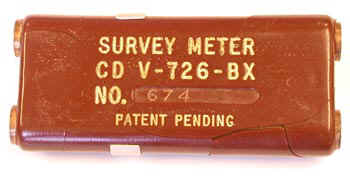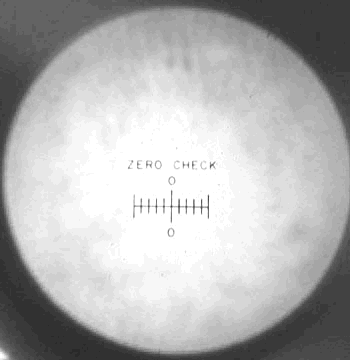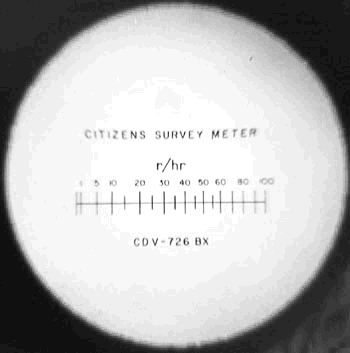CD V-726-BX R & D Prototype Pocket Dosimeter (1960-1962)

Bendix produced a CD V-736, a CD V-746, and a CD V-756 (for their Family Radiation Measurement Kit), but they never produced a CD V-726. That’s common knowledge. But even though they never produced a CD V-726, they did think about it, and this neat little “Citizens Survey Meter” is an experimental R&D prototype. Hence the “X” at the end of the designation: CD V-726-BX. For some reason the brown plastic “case” is cracked in a couple of places. Perhaps it failed the drop test or someone sat on it.
At first glance, it looks like two standard pocket dosimeters packaged together as a single unit. And that’s exactly what I thought when I first saw it—two dosimeters with different ranges. But when you look through the eyepiece on the right, you see a scale that reads 0 to 100 R/hr! This thing is a ratemeter! And we’re not talking about the CD V-736 kind of ratemeter—a standard instrument calibrated to read R/hr when exposed in a radiation field for a specific period. This device measures the exposure rate irrespective of the deployment period. Clearly there had to be some limitations associated with the response time and other factors but what these were, I don’t know. It didn’t come with an instruction manual.


When you look through the other eyepiece, the one on the left, you see a scale with zero in the center that is identified as the “Zero Check” My guess is that both “dosimeters” were zeroed prior to the measurement and that as long as the hairline on the Zero Check scale was positioned at zero, the ratemeter reading in R/hr could be used. The range of the ratemeter coincided with the highest dose rate recommended by the Office of Civil Defense for the public: 100 R/hr.
There were actually three versions of the CD V-726 under development in 1961: the CD V-726AX, a "standard" GM survey meter, the CD V-726BX described here, and the CD V-726DX, a GM meter incorporated into a radio. It is possible that the CD V-726 designation was used for R&D purposes and that any models that went into production would have employed a different number. According to the Office of Civil Defense annual report for 1962, Bendix Corp. began working on this "Citizens Survey Meter" in October of 1959 and completed its development in FY 1962.
Donated by the Federal Emergency Management Agency courtesy of Carl Siebentritt.
Reference
How Civil Defense Measures Harmful Radiation, Nucleonics, January 1962, p. 67-68.
